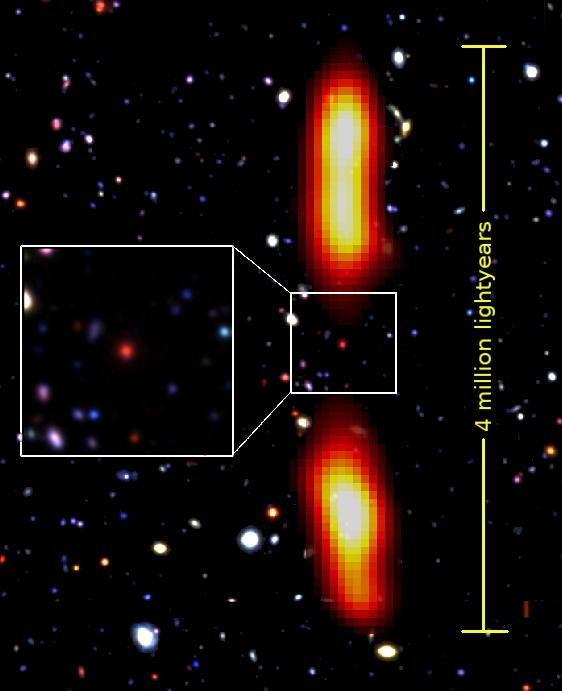
Quella che vedete è un’immagine ottica con due lobi radio (in giallo e rosso). Il buco nero supermassiccio al centro della galassia rossa (la si vede meglio zoomata nell’inserto bianco) ha portato alla formazione di questi giganti lobi radio. Crediti: Prathamesh Tamhane/Yogesh Wadadekar
Una radiogalassia gigante è stata avvistata a 9 miliardi di anni luce da noi (costellazione della Balena) con l’indiano Giant Metrewave Radio Telescope (GMRT) presso il National Centre for Radio Astrophysics (NCRA, TIFR). J021659-044920 (questo il suo nome scientifico) è caratterizzata da emissioni radio molto potenti e che da un capo all’altro misurano ben 4 milioni di anni luce (si tratta di una radiogalassia gigante molto rara, soprattutto a queste distanze).
Ma come è possibile che galassie con una dimensione ottica di centomila anni luce possano produrre emissioni radio di diversi milioni di anni luce? Il responsabile, come spesso accade per altri fenomeni celesti, potrebbe essere il buco nero supermassiccio al centro della radiogalassia gigante, che produce enormi getti di plasma caldo in direzioni opposte dando vita anche a grandi lobi radio. Quando il “rifornimento” viene a mancare, il buco nero smette di produrre questi getti radio in pochi milioni di anni. Ed è proprio il caso di J021659-044920, ormai nelle fasi finali della sua vita. I lobi radio si stanno affievolendo e la perdita di energia si manifesta anche con il trasferimento di energia ai fotoni della radiazione cosmica di fondo attraverso un processo noto effetto Compton inverso. Si tratta di un meccanismo che porta all’indebolimento delle emissioni dei raggi X, che provengono proprio dai lobi radio di questa galassia.
Oggetti celesti morenti come J021659-044920 possono essere osservati agevolmente con radiotelescopi a basse frequenze come – appunto – GMRT, il più grande radiotelescopio al mondo che lavora sulle basse frequenze, anche se fra qualche anno il primato verrà preso dallo Square Kilometre Array – SKA (GMRT viene già utilizzato da qualche mese come pathfinder di SKA). Le antenne indiane del GMRT operano ormai da 13 anni: si tratta di 30 corpi pienamente movimentabili di ben 45 metri di diametro ciascuno e che insieme garantiscono un’area di raccolta di ben 30,000 metri quadrati, coprendo un range di frequenze da 150 MHz to 1.5 GHz.
Lo studio è stato pubblicato su MNRAS e per le loro analisi gli esperti hanno utilizzato dati provenienti da osservazioni precedenti effettuare con l’XMM-Newton Space Telescope ai raggi X, il Subaru telescope nel campo dell’ottico, l’Infrared Telescope nel vicino infrarosso, lo Spitzer Space Telescope nel medio infrarosso e il Jansky Very Large Array nelle alte frequenze radio. Utilizzando i dati di più telescopi che coprono tutto lo spettro dell’elettromagnetico, gli astronomi sono stati in grado di effettuare un’analisi completa e incredibilmente dettagliata dell’ambiente attorno a questa galassia lontana.
Per saperne di più:
Leggi QUI lo studio pubblicato su MNRAS: “J021659-044920: a relic giant radio galaxy at z ˜ 1.3”, di Tamhane P. et al.




